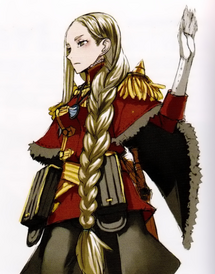Katherine I of Atmora
This article is incomplete because it is pending further input from participants, or it is a work-in-progress by one author. Please comment on this article's talk page to share your input, comments and questions. Note: To contribute to this article, you may need to seek help from the author(s) of this page. |
| Katherina I | |||||||||
|---|---|---|---|---|---|---|---|---|---|
| Head of the Commonwealth | |||||||||
 Formal portrait c. 1939–1945 | |||||||||
| High Queen of Atmora and Mizuho; Queen of Lieseltania | |||||||||
| Reign | 7 January 1938 – 23 May 1980 | ||||||||
| Coronation | 23 November 1939 | ||||||||
| Predecessor | Frederick IV | ||||||||
| Successor | Willem III | ||||||||
| Prime Minister(s) | See list | ||||||||
| Born | Princess Katherina of Lieseltania 14 December 1916 Coudenberg Palace, Pruzhana, Lieseltania | ||||||||
| Died | 21 May 2013 (aged 96) Ravenhof Castle, Ypenburg, Lieseltania | ||||||||
| Burial | 2 June 2013 | ||||||||
| Spouse | Prince Nikolaas | ||||||||
| Issue | Willem III Princess Eleanora Princess Madeleine Prince Casimir | ||||||||
| |||||||||
| House | Wolf | ||||||||
| Father | Frederick IV | ||||||||
| Mother | Princess Madeleine of Gallia | ||||||||
| Religion | Church of Visenna | ||||||||
Katherine I (Katherina Françoise Alexandra; 14 December 1916 – 21 May 2013) was High Queen of Atmora and Mizuho, and the Queen of Lieseltania from 11 September 1938 after the assassination of her father Frederick IV, and then until her abdication in 1980.
Born during the reign of her grand-aunt High Queen Elizabeth, Katherina was fifth in line of succession behind her uncle Prince Edward of Lieseltania, and her father Prince Frederick of Lieseltania, till the 1931 September Crisis in which the Young Voshans had assassinated most of the senior members of the Atmoran royal family. With the death of her grand-aunt High Queen Elizabeth, Katherine would be made the Princess of Wolf with the ascension of her father as High King Frederick IV in 1931. In 1937 Katherina married Count Nikolaas Ulzens van Alsemberg, with whom she would have three children with Willem III, Eleanora, and Madeleine. Following the unexpected death of her father Frederick IV in the Belgarad railway bombing in 1938, Katherina ascended the throne as High Queen of Atmora and Queen of Lieseltania.
Her reign oversaw the beginning of the Third Voshan War, and the young High Queen would offer little resistance to her Chancellor Louwrens van Geuzendam during the early stages of the war. Katherina would lead the failed coup d'ètat against Chancellor Geuzendam in 1943. Following her failed putsch Katherina would then go on and lead the Castaliense Confederation, sparking the Atmoran Civil War and allying herself against Geuzendam with Vozh and Aravea in 1943. The defeat of the fascists, the death of Geuzendam in 1946, and Katherina's surrender of Atmora to the Allies. Would garner sympathy leading to her not being prosecuted in the Leidenschdam Trials, and being allowed to remain on the throne. For the remainder of her reign, Katherina would oversee the post-war reconstruction of Atmora along with the mending of relations with Vozh and Aravea. Along with fighting the remnants of fascist and communist elements during the Atmoran Interior War, which would persist even after her reign. Katherina on 23 May 1980, would abdicate the throne of Atmora and Lieseltania to her son Willem, Prince of Wolf.
Katherina is best renowned as a symbol of Atmoran unity and resistance against the Geuzendam regime, particularly because of her part in Operation Primrose and the landing of royalist troops in the Kingdom of Larsenburg. Additionally she is known as a stalwart defender of the Atmoran constitution during both the Atmoran Civil War and the Atmoran Interior War.
Early life and education
Katherina was born on 14 December 1916, in the Coudenberg Palace, Pruzhana. She was the first child of Prince Frederick of Lieseltania (later High King Frederick IV) and his wife Princess Madeleine of Gallia (later High Queen Madeleine). Her father was the second son of the Princess Maëlys of Atmora and Count Albert de Maseneer van Mostinckx, and her mother was the third daughter of King Charles III of Gallia and Princess Katherina of Lippe. Her childhood was characterised as nothing of great importance as it was never considered that Katherina would ever take the throne as her grand-aunt High Queen Elizabeth had a son Karel, Prince of Wolf and her position as fifth in line to the throne.
Growing up far removed from the Atmoran royal court, together with her only sibling and sister Princess Winter of Atmora in De Gestelhof Palace, Pruzhana.
Princess of Wolf
Reign
Accession
Third Voshan War
Royalist putsch
Yet by 1943 and the continued erosion of Atmoran democracy and freedoms under the fascist Chancellor, Katherina would grow tired of her Chancellor constantly overreaching his bounds and, together with the Corps of Royal Guards and other royalist officers would attempt to overthrow and arrest the Chancellor. With the failed coup d'ètat by the High Queen and royalist factions, the High Queen would retreat to Asvarre beginning the Atmoran Civil War and leading the Castaliense Confederation from the Kingdom of Asvarre
Atmoran Civil War
Katherine having escaped Lieseltania with the Atmoran Seventh Fleet abroad HMS Henrietta de Grote a Asvarra class fast battleship dreadnought in daring crossing of the Halkeginian Sea in the Battle of Cape Alava. 29 November 67 kilometres south of the coast of Cape Alava, Brandenburg Admiral Herman Buitenhuis of the Rijkskriegsmarine Home Fleet intercepted and attempted to capture the High Queen. Outnumbered by Admiral Buitenhuis, Admiral Hossen of the Seventh Fleet first priority was to get the High Queen away from Cape Alava as quickly as possible. She would be ultimately saved by Schout-bij-nacht Maurits Sievering who be later posthumously promoted to Vice Admiral for his last stand sacrificing his battlecruiser and two destroyers to delay the Home Fleet from capturing the High Queen.
With the battle of Cape Alava won and the fascist Home Fleet in shatters after the naval action. The High Queen and the Seventh Fleet managed to make it to port in Straatsburg, Alsatia. The High Queen after her arrival in Alsatia made a royal proclamation at Castaliens, Asvarre denoucing Chancellor Geuzendam and the fascist government in Alexandria convening the conference of Sovereigns in Castaliens. The High Queen granted emergency powers by the federal princes, formed provisional government and the Castaliense Confederation on 3 December 1943.
TBD.....
The High Queen would make court at the Schoonenburg Palace in Castaliens directing the Free Atmoran Armed Forces in operations against Geuzendam. The High Queen and her Generals would plan and win the Aurician Campaign in 27 March 1945. Along with the coordination and execution of operations in mainland Atmora by the Office of Special Assignments (BBB).
With Vozh and Aravea reaching Novigrad on 7 June 1945, with the Battle of Novigrad marking three months of brutal urban combat in the war. The Free Atmoran Forces were planning Operation Primrose, with a series of deceptions and feigns by Aravea and Vozh to pull units away from Western Atmora. The High Queen commenced Operation Primrose the largest naval invasion on 29 October 1945. With 145,000 soldiers and nearly 7,000 ships primarily from the Royal Atmoran Navy and Royal Mizuhese Navy landed in Ariën, Southern Larsenburg. By 13 November, the royalist forces liberated Melverre the capital of the Kingdom of Larsenburg. With the liberation of Melverre by royalist forces the High Queen made her way to mainland Atmora and on 16 November 1945 the High Queen made a broadcasted a speech from the Royal Palace of Melverre celebrating the liberation of the city:
Let it be known on the 13 November the people of Melverre took back their city. Took back their city from the clutches of fascism, casting aside the chains of tyranny. To the people of Larsenburg and of states of the Confederation I have returned. The hour has come at last when shall see the end of the Geuzendam government and restoration of our great Confederation. The armies of a Free Atmora have arrived to break the chains cast upon you, together we can end the Geuzendam regime. Citizens the time is now form your battalions! March, march upon the oppressors cast them down! The fatherland calls upon all of you, the time for action is now!
Return to Lieseltania

Following the High Queen's speech in Melverre was the formation of the Landstorm Battalions, by 7 February 1946 the Gallian Landstorm, Leuven Landstorm, and the I. Royal Gallian Army Corps (XIV Army Corps) liberated Gallia and Leuven from the Republic of Atmora. The High Queen would proceed to hold court at the Royal Palace of Melverre following the liberation of Larsenburg, refusing to return to Castaliens after her government's worries of her safety so close to Lieseltania. With the High Queen famously stating:
I have just returned, the crown shall not cower in fear across the sea while her citizens fight in the countryside for our liberation! If the Chancellor so wishes for my head he is free to come and get it.
The High Queen would remain in Melverre for the remainder of the war sharing the same dangers as the people of Western Atmora. However with the Royal Atmoran Air Force winning air superiority over Western and Central Atmora by late February 1946. The risk of bombings from the Republican Air Force would nearly vanish. The High Queen would move court to Anthold following the liberation of the Karth in 26 April 1946, finally returning to Lieseltania nearly three years after her exile. With her return to her own realm as Queen of Lieseltania raised the Karth Landstorm, Lieseltanian Landstorm, and two regiments of Stoottroepen.
Hearing of the return of the Queen in the Karth Field Marshal Klaas van Corbach-Boesschen, Field Marshal Sietse E. Bastein, General Henri Heukers, General Arnout Meinders, , Air Chief Marshal Paulus Kleise, Air Chief Marshal Henri René Sjoerts, Admiral Emiel Verrier, and other high ranking officers reaffirmed their allegiance and the allegiances of their men to her. With Field Marshal Klaas van Corbach-Boesschen and Field Marshal Sietse E. Bastein leading the Third and Fifth Royal Lieseltanian Armies on Alexandria in the 1946 Atmoran coup d'etat on 25 June. By 26 June, the Blue Guards commanded by Colonel Siebren Warners having defeated the Republican Guards guarding Slot Meseberg the official residence of Chancellor Louwrens van Geuzendam threw the Chancellor out of the window. The Blue Guards would drag the Chancellor Geuzendam behind Colonel Warners staff car down the streets of Alexandria in front of the Queen's Square outside the Royal Palace of Alexandria. Colonel Warners would hold a trial in the Queen's Square where the Royal Lieseltanian Landstorm after his sham trail hanged and burnt his body in front of the Royal Palace.
Reconstruction and Interior War
Legacy
Titles, styles, honours and arms
- 14 December 1916 – 11 September 1931: Her Royal Highness Princess Katherina of Lieseltania and Gallia
- 11 September 1931 – 7 January 1938: Her Royal Highness the Princess of Wolf
- 7 January 1938 – 23 May 1980: Her Majesty Katherina , by the Grace of God, High Queen of Atmora and Mizuho, Queen of Lieseltania
- 23 May 1980 – 23 May 2013: Her Majesty High Queen Katherina